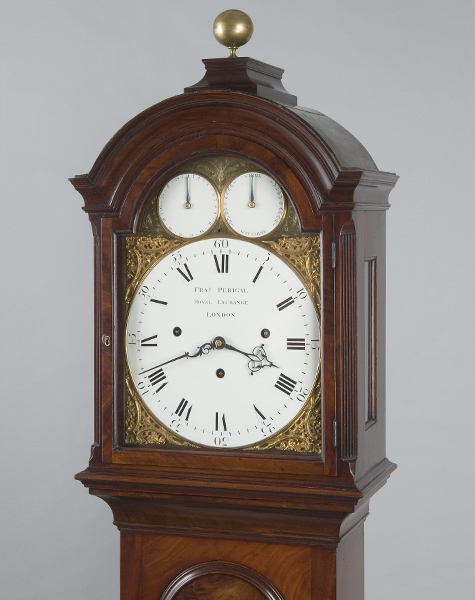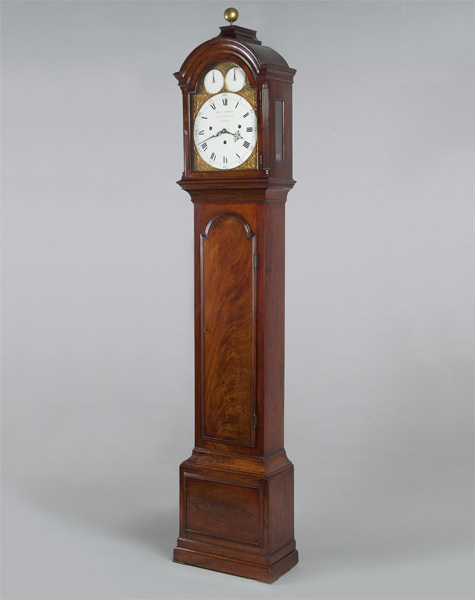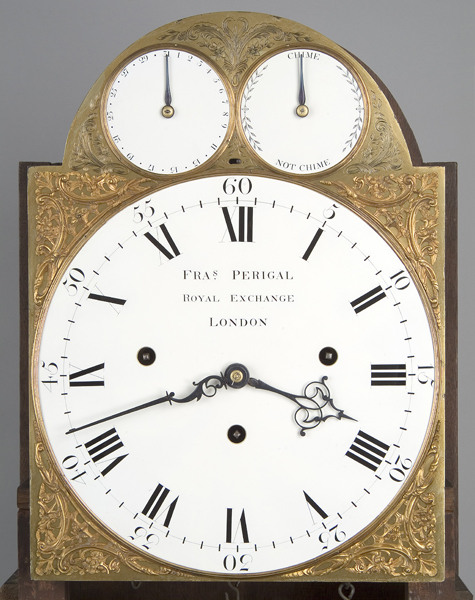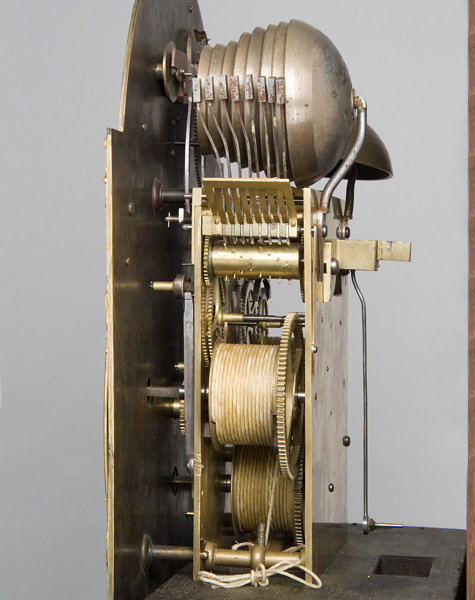[javascript protected email address]

Francis Perigal, London




Circa 1785
Sold
7ft 3 inches high
A fine and rare George III mahogany quarter striking longcase clock with enamel dials. Case The mahogany case has a break arch hood with canted and fluted corners with a three sided shaped pedestal and brass ball finial. The slim dial door having a flat veneer. The rectangular side apertures are glazed. The trunk has a break arch door with well figured mahogany veneer and fine ‘bolection’ moldings. The tapered base with a matching raised panel and double skirting with front pad feet. Dial The 12 inch dial plate is engraved in the arch with a strike/silent lever to the centre. It is mounted with vitreous enamel dials, the 11 5/8 inch main dial is signed ‘Frans. Perigal, Royal Exchange, London’ and is flanked by fine Rococo spandrels which, together with the dial rings, retain their original fire gilding. The two subsidiaries in the arch are both 3 1/2 inches in diameter, the date dial mounted to the left and chime/not chime to the right. The date dial is inscribed in enamel on the back ‘for Mr Perigal’. The hands are finely pierced out and shaped. Movement The massive 6 pillar, 8-day movement is substantial with unusually heavy plates. It has a recoil anchor escapement with a long steel crutch and single steel pin into the substantial iron pendulum rod with a large brass lenticular bob. It is rack striking with countwheel quarter chime on eight bells, the hour striking on a separate large bell. The countwheel quarters can be reset using a trip cord accessed through the trunk door. Francis Perigal, London Francis Perigal (1st) founded the firm of ‘Perigal & Son’. He was free of Clockmakers Company (CC) in 1741 and Master of CC in 1756. He was based at 9, Threadneedle St., Royal Exchange and for a short period (1770) at 2, Threadneedle St., Royal Exchange. His son, also Francis (2nd), was apprenticed to his father on 16 January 1748 and freed 5 April 1756. He was Master in 1775. Based at 9, Threadneedle St., Royal Exchange. Francis S. Perigal, also in the firm of ‘Perigal and son’, but relationship unknown, was free of the CC in 1781, Master in 1805, died 1824. Watchmaker to the King and later based in New Bond Street. Francis (3rd) was apprenticed to his father Francis (2nd) on 6 July 1778 and freed 9 January 1786. He was Master in 1806. Continued at 9, Threadneedle St., Royal Exchange. Francis Perigal, Royal Exchange, London (Cont.) Comments This clock case is of exemplary quality and represents the most sophisticated form of mahogany case reserved for the finest examples of this period. The construction is exactly as one would expect of a clock of this quality, using solid mahogany with mahogany veneers, pine blocks and a backboard of oak. The base flares slightly from the moulding to the skirt, producing a balanced line to the eye and removing any appearance of being ‘top-heavy’. This is a feature of the best cabinetwork and was reserved for the finest cases. The clock is one of a small number examples made in this style. Although the case is similar in appearance to cases produced for Mudge & Dutton, there are a small number of differences, and it is more likely that this case was from the same workshop as similar examples made for John Holmes. The movement is also of the finest quality. Construction is on a large scale with particularly thick plates and heavy pillars enabling maximum stability. Unusually, the clockmaker has made use of a countwheel for the quarters rather than the more commonplace rack system. To avoid difficulty in resetting the quarters without removing the hood, a trip lever has been provided with a pull bob accessed through the trunk door. The original pendulum is a particularly pleasing example with a heavy forged iron rod and a brass cased large bob. The dial is, perhaps, the most unusual feature. The spandrels and dial rings are mercury (fire) gilded a process which was very expensive and by this time reserved for only the best dials. The production of enamel dial in England at this period was also confined to a very small number due to difficulties in firing and the vast majority are seen on table clocks on a smaller scale. As the size of the dial increases so do the problems with production and also the consequent costs. Hence, only a very small number of longcase clocks are found with enamel dials and these appear to be confined to the finest makers of this period. Overall, every aspect of this clock is of superb quality with no expense spared. Bearing this in mind, it seems unlikely that this was made simply as stock for Perigals shop and was possibly a special commission for an important and/or wealthy customer.
